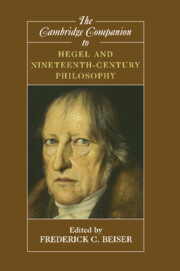Book contents
- Frontmatter
- Introduction: The Puzzling Hegel Renaissance
- 1 Hegel: A Life
- 2 Ancient Skepticism, Modern Naturalism, and Nihilism in Hegel’s Early Jena Writings
- 3 Hegel’s Phenomenology as a Systematic Fragment
- 4 The Independence and Dependence of Self-Consciousness: The Dialectic of Lord and Bondsman in Hegel's Phenomenology of Spirit
- 5 Hegel’s Logic
- 6 Hegel’s Idealism
- 7 Hegel and Hermeneutics
- 8 Hegel’s Social Philosophy
- 9 Hegel’s Philosophy of Religion
- 10 Hegel and Mysticism
- 11 Philosophizing about Nature: Hegel’s Philosophical Project
- 12 Hegel’s Criticism of Newton
- 13 The Logic of Life: Hegel’s Philosophical Defense of Teleological Explanation of Living Beings
- 14 Hegel and Aesthetics: The Practice and “Pastness” of Art
- 15 The Absence of Aesthetics in Hegel’s Aesthetics
- Bibliography
- Index
15 - The Absence of Aesthetics in Hegel’s Aesthetics
Published online by Cambridge University Press: 28 July 2009
- Frontmatter
- Introduction: The Puzzling Hegel Renaissance
- 1 Hegel: A Life
- 2 Ancient Skepticism, Modern Naturalism, and Nihilism in Hegel’s Early Jena Writings
- 3 Hegel’s Phenomenology as a Systematic Fragment
- 4 The Independence and Dependence of Self-Consciousness: The Dialectic of Lord and Bondsman in Hegel's Phenomenology of Spirit
- 5 Hegel’s Logic
- 6 Hegel’s Idealism
- 7 Hegel and Hermeneutics
- 8 Hegel’s Social Philosophy
- 9 Hegel’s Philosophy of Religion
- 10 Hegel and Mysticism
- 11 Philosophizing about Nature: Hegel’s Philosophical Project
- 12 Hegel’s Criticism of Newton
- 13 The Logic of Life: Hegel’s Philosophical Defense of Teleological Explanation of Living Beings
- 14 Hegel and Aesthetics: The Practice and “Pastness” of Art
- 15 The Absence of Aesthetics in Hegel’s Aesthetics
- Bibliography
- Index
Summary
“Presentness is grace.”
Michael Fried, Art and ObjecthoodA central topic of modern aesthetics after Kant is the problem of aesthetic judgment. The question concerns the proper understanding of logical form of such judgments (such as “this is beautiful”) and their possible objectivity. But Hegel does not offer, anywhere in his discussions of fine art, a recognizable theory of aesthetic judgment. He does not even work out a well defined account of aesthetic experience. This divergence from much modern aesthetic theory is largely due to the complexity of the concept of art itself as Hegel invokes it. For Hegel's treatment is famously historical; the account of the nature of art is narrative rather than analytic. And he arrives at a most paradoxical conclusion as a result of this narrative: much of what we consider postclassical art (what Hegel calls “romantic” art) is treated as art in the process of “transcending itself as art,” somehow “against itself as art,” and as much a manifestation of the “limitations” and increasingly dissatisfied “life” of the practice of the production and appreciation of art as it is a part of a continuous tradition. (The even deeper paradox is that romantic art is all of this “as art. ”) In less dramatic terms, Hegel denies the autonomy of the aesthetic, or at least its complete autonomy, and this denial is the basis of the claim that art must be considered as a social institution linked to the development of the norms and values of a society as a whole, and that it is best understood in terms of its similarities with religion and philosophy and not as autonomous.
- Type
- Chapter
- Information
- Publisher: Cambridge University PressPrint publication year: 2008
- 6
- Cited by



